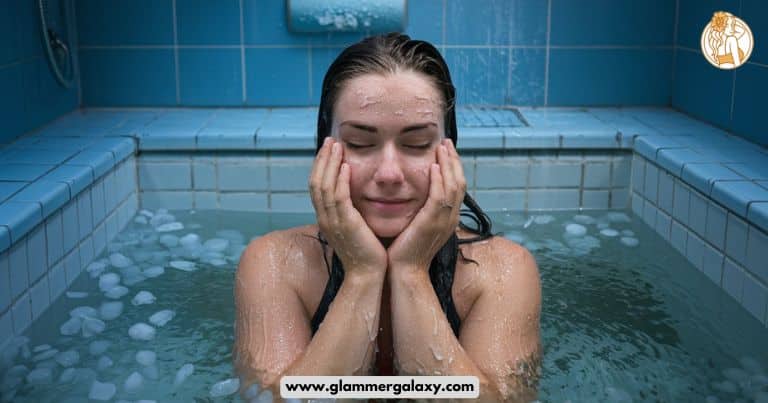Ice baths have become popular among athletes, fitness enthusiasts, and health-conscious individuals. As this chilly practice gains traction, a burning question emerges : Showering after an ice bath is good or is it better to let your body warm up naturally?
This comprehensive guide will explore cold therapy, and the science behind ice baths, the showering debate, and how to maximize the benefits of this invigorating practice.
The Science Behind Ice Baths
1-Physiological Effects on the Body
Ice baths, also known as cold-water immersion or cold plunges, trigger a cascade of physiological responses in the body. When you submerge yourself in cold water, typically between 50-59°F (10-15°C), your body undergoes several changes:
- Vasoconstriction: Blood vessels near the skin’s surface constrict, redirecting blood flow to vital organs.
- Reduced inflammation: Cold exposure can help decrease inflammation in muscles and joints.
- Hormonal responses: The body releases stress hormones like norepinephrine and cortisol, which can have both stimulating and anti-inflammatory effects.
- Metabolic boost: Cold exposure can temporarily increase metabolism as the body works to maintain core temperature.
- Immune system stimulation: Some studies suggest that controlled cold exposure may enhance immune function.
Table: Temperature Ranges for Cold Therapy
| Type of Cold Therapy | Temperature Range |
| Ice Bath | 50-59°F (10-15°C) |
| Cold Shower | 50-68°F (10-20°C) |
| Cryotherapy | -166 to -220°F (-110 to -140°C) |
Potential Benefits for Recovery and Performance
Research suggests that ice baths may offer several benefits:
- Reduced muscle soreness: Cold therapy can help alleviate delayed onset muscle soreness (DOMS).
- Improved recovery: Ice baths may accelerate recovery between intense training sessions.
- Enhanced circulation: The constriction and subsequent dilation of blood vessels can improve overall circulation.
- Mental toughness: Enduring cold exposure can build psychological resilience.
- Potential performance enhancement: Some studies indicate that regular cold exposure might improve endurance and power output.
- Sleep quality: Cold therapy may contribute to better sleep, especially when done in the evening.
“Ice baths have been a game-changer for my recovery routine. They help me bounce back faster between tough workouts and have improved my overall performance.” – Sarah Johnson, Marathon Runner
See Also : Does Shea Butter Expire? Keep It Lush!
Risks and Precautions
While ice baths offer potential benefits, they’re not without risks:
- Hypothermia: Prolonged exposure to cold water can dangerously lower body temperature.
- Cardiac stress: The sudden cold shock can stress the cardiovascular system.
- Skin irritation: Some individuals may experience skin sensitivity or irritation.
- Nerve damage: Extremely cold temperatures or prolonged exposure can potentially damage peripheral nerves.
- Muscle tension: In some cases, cold exposure may cause muscle stiffness or cramping.
It’s crucial to consult with a healthcare professional before incorporating ice baths into your routine, especially if you have pre-existing medical conditions.
To Shower or Not to Shower: Unraveling the Debate
The question of whether to shower after an ice bath has sparked considerable debate in the fitness and recovery community. Let’s explore both sides of the argument.
Arguments for Immediate Showering
- Comfort and warming up: A warm shower can help raise body temperature more quickly, providing immediate relief from the cold.
- Hygiene considerations: If you’ve used a public ice bath, showering afterward can help maintain personal hygiene.
- Time efficiency: For those with busy schedules, showering immediately can save time in the recovery process.
- Mental reset: A shower can provide a psychological transition from the intense cold experience to normal activities.
Arguments Against Immediate Showering
- Prolonging cold therapy effects: Some experts argue that allowing the body to warm up naturally extends the benefits of cold exposure.
- Gradual temperature transition: A sudden shift from cold to hot might negate some of the anti-inflammatory benefits of the ice bath.
- Enhanced adaptation: Letting the body warm up on its own may promote greater physiological adaptation to cold stress.
- Avoiding temperature shock: Rapid temperature changes can be stressful for the body’s regulatory systems.
Dr. Emily Carter, a sports physiologist, explains: “The key is to find a balance. While immediate showering might feel good, it could potentially counteract some of the physiological benefits of the ice bath. A gradual warm-up might be more beneficial for overall recovery and adaptation.”
The Optimal Ice Bath Experience: A Step-by-Step Guide
To reap the full benefits of cold therapy, follow these steps for a safe and effective ice bath experience:
Preparation
- Safety checks and equipment:
- Ensure you have a suitable container or tub
- Gather ice, a thermometer, and a timer
- Have warm clothes ready for after the bath
- Consider having a companion nearby for safety
- Water temperature and duration guidelines:
- Aim for a water temperature between 50-59°F (10-15°C)
- Start with short durations (2-3 minutes) and gradually increase to 10-15 minutes as you build tolerance
- Use a reliable thermometer to monitor water temperature
The Immersion Process
- Breathing techniques:
- Practice deep, controlled breathing to manage the initial cold shock
- Focus on inhaling through your nose and exhaling slowly through your mouth
- Try the “box breathing” technique: inhale for 4 seconds, hold for 4 seconds, exhale for 4 seconds, hold for 4 seconds, and repeat
- Mental strategies for enduring the cold:
- Use positive self-talk and visualization
- Set small goals (e.g., “I’ll stay in for 30 more seconds”)
- Focus on the potential benefits to your recovery and performance
- Practice mindfulness or meditation to stay present and calm
- Body position and movement:
- Submerge your body up to the neck if possible, keeping your head above water
- Gently move your limbs to prevent complete numbness
- If full-body immersion is too intense, start with lower body immersion and gradually work your way up
Post-bath Practices
- Gradual rewarming methods:
- Gently towel dry and put on warm, dry clothes
- Engage in light movement to promote blood flow
- Consider using a warm (not hot) compress on extremities if needed
- Avoid direct heat sources like heaters or hot water bottles
- Hydration and nutrition tips:
- Drink warm fluids to help raise core body temperature
- Consume a balanced meal or snack to support recovery
- Consider warm herbal teas or bone broth for additional nutrients and warmth
You might like this post too : Nail Polish on Ringworm How Fast Does It Work?
Timing Your Shower: Finding the Sweet Spot
The optimal timing for a post-ice bath shower remains a subject of debate. Here’s a breakdown of the pros and cons:
Immediate Showering
Pros:
- Quick relief from cold discomfort
- Feels psychologically rewarding
- Convenient for those with time constraints
- May help prevent prolonged shivering
Cons:
- May reduce the duration of cold therapy benefits
- Could potentially shock the system with rapid temperature change
- Might interfere with the body’s natural adaptive processes
Delayed Showering
Pros:
- Allows the body to warm up naturally, potentially extending cold therapy benefits
- May enhance the body’s adaptive responses to cold exposure
- Could lead to greater improvements in cold tolerance over time
- Provides an opportunity to practice mindfulness and body awareness
Cons:
- Prolonged discomfort for some individuals
- May not be practical in all situations (e.g., if you need to quickly return to work or other activities)
- Could lead to excessive shivering in some cases
Factors Influencing the Decision
- Individual tolerance and goals: Your personal comfort level and specific recovery objectives should guide your decision.
- Environmental conditions: Consider the ambient temperature and your post-bath activities.
- Time of day: Evening ice baths might benefit from delayed showering to promote better sleep.
- Training phase: During intense training periods, a more gradual warm-up might be beneficial.
Expert Recommendations
While there’s no one-size-fits-all answer, many experts suggest waiting at least 30 minutes to an hour before showering. This allows your body to gradually return to its normal temperature while potentially maximizing the benefits of cold exposure.
Dr. Michael Chen, a sports medicine specialist, advises: “If you can tolerate it, try to avoid hot showers immediately after an ice bath. Instead, focus on gentle rewarming through light movement and warm clothing. If you must shower, opt for lukewarm water rather than hot. This approach helps maintain the benefits of cold therapy while ensuring comfort and safety.”
Beyond the Bath: Maximizing the Benefits
To get the most out of your ice bath routine, consider these complementary practices:
Complementary Recovery Techniques
- Contrast therapy: Alternating between cold and warm exposures (e.g., ice bath followed by a sauna session)
- Compression garments: Wearing compression clothing after cold therapy may enhance circulation
- Foam rolling: Self-myofascial release can complement the muscle recovery process
- Gentle stretching: Light, dynamic stretches can help improve flexibility and blood flow
- Meditation or mindfulness: Practicing mental relaxation techniques can enhance the overall recovery experience
Integrating Ice Baths into a Training Regimen
- Timing: Schedule ice baths after intense workouts or competitions
- Frequency: Start with 1-2 sessions per week and adjust based on your body’s response
- Duration: Gradually increase exposure time as you build tolerance
- Periodization: Consider using ice baths more frequently during high-intensity training phases
- Recovery days: Incorporate ice baths on rest days to support overall recovery
Listening to Your Body: Personalization is Key
Remember that everyone’s response to cold therapy is unique. Pay attention to how your body reacts and adjust your routine accordingly. Some may benefit from frequent ice baths, while others might find occasional use more beneficial.
- Keep a journal to track your experiences and recovery progress
- Note any changes in performance, soreness, or overall well-being
- Be willing to adjust your routine based on your body’s feedback
- Consult with a sports medicine professional or coach to fine-tune your approach
Explore this interesting article : Setting Spray Alternatives Unveiling the Hidden Gems
Common Myths and Misconceptions Debunked
Let’s address some prevalent myths surrounding ice baths and post-bath practices:
- Myth: “Colder is always better”
Truth: Extremely cold temperatures can be dangerous and counterproductive. Stick to the recommended range of 50-59°F (10-15°C) for safety and efficacy. - Myth: “Ice baths are suitable for everyone”
Truth: While many can benefit from cold therapy, it’s not appropriate for individuals with certain medical conditions, such as cardiovascular problems or Raynaud’s disease. - Myth: “You must shower immediately after”
Truth: As discussed earlier, immediate showering is a personal choice and not a necessity. Many experts recommend a gradual warm-up process instead. - Myth: “Longer ice baths yield better results”
Truth: Extended exposure can be harmful. Start with short durations and gradually increase to a maximum of 15 minutes. - Myth: “Ice baths eliminate all muscle soreness”
Truth: While they can help reduce soreness, ice baths are not a cure-all. They should be part of a comprehensive recovery strategy. - Myth: “Ice baths are only for elite athletes”
Truth: Anyone engaging in regular physical activity can potentially benefit from cold therapy, when used appropriately. - Myth: “You should take an ice bath before exercise”
Truth: Ice baths are generally more beneficial for recovery after exercise, not as a pre-workout routine.
Real-life Experiences: Athletes and Enthusiasts Speak
To provide a well-rounded perspective, let’s look at some real-world experiences with ice baths and post-bath practices:
- Professional Athlete Case Study:
Tom Richards, a professional triathlete, shares: “I’ve experimented with various post-ice bath routines. I’ve found that waiting about 45 minutes before taking a lukewarm shower works best for me. It allows my body to adapt to the cold exposure while preventing any discomfort from lingering too long. I’ve noticed significant improvements in my recovery time and overall performance since incorporating this routine.” - Weekend Warrior Testimonial:
Lisa Chen, an avid CrossFit enthusiast, reports: “I was skeptical about ice baths at first, but they’ve become an essential part of my recovery. I usually wrap up in warm clothes and sip on herbal tea for about an hour after the bath. I find this helps me feel energized without negating the benefits of the
cold therapy. My muscle soreness has decreased, and I feel more prepared for my next workout.” - Chronic Pain Management:
John Miller, who uses ice baths to manage arthritis pain, explains: “I’ve learned to listen to my body. Some days, I feel the need for a warm shower shortly after the ice bath to manage my joint stiffness. Other times, I’m comfortable letting my body warm up naturally. Flexibility in my approach has been key. Overall, I’ve experienced a noticeable reduction in joint pain and improved mobility since starting this routine.” - Mental Health Perspective:
Emma Thompson, a yoga instructor, shares: “I started taking ice baths for physical recovery, but I’ve found the mental health benefits to be equally significant. The practice of enduring discomfort has translated into greater resilience in my daily life. I typically meditate for about 20 minutes after my ice bath before taking a lukewarm shower. This routine has become a form of moving meditation for me, improving both my physical and mental well-being.”
These varied experiences underscore the importance of personalization in your ice bath and post-bath routine. What works for one person may not be ideal for another, highlighting the need for individual experimentation and adjustment.
Safety First: When to Avoid Ice Baths
While ice baths can be beneficial for many, they’re not suitable for everyone. Be cautious if you have:
- Heart conditions
- High blood pressure
- Open wounds or skin infections
- Raynaud’s syndrome
- Pregnancy
- Recent surgery
- Peripheral neuropathy
- Certain autoimmune disorders
Additionally, be aware of the following safety considerations:
- Hypothermia risk: Monitor for signs of excessive cold, such as intense shivering, confusion, or slurred speech.
- Cold urticaria: Some individuals may have an allergic reaction to cold exposure, causing hives or swelling.
- Medication interactions: Certain medications may affect your body’s response to cold. Consult your doctor if you’re on any medications.
- Overuse: Excessive use of ice baths can potentially lead to negative effects. Stick to recommended frequencies and durations.
Always consult with a healthcare professional before starting any new recovery regimen, including ice baths. They can provide personalized advice based on your individual health status and fitness goals.
The Future of Cold Therapy
As interest in cold therapy grows, so does the body of research surrounding it. Here are some emerging trends and areas of study:
- Precision cold therapy: Researchers are exploring how to tailor cold exposure protocols to individual needs and genetic profiles. This could lead to more personalized and effective cold therapy regimens.
- Neurological impacts: Studies are investigating the potential effects of cold therapy on brain health and cognitive function. Preliminary research suggests possible benefits for mental clarity and mood regulation.
- Metabolic benefits: Ongoing research is examining how controlled cold exposure might influence metabolism and body composition. Some studies indicate potential benefits for brown fat activation and metabolic rate.
- Immune system modulation: Scientists are investigating how cold exposure might influence immune function, with potential implications for overall health and disease resistance.
- Technological advancements: New devices are being developed to provide more controlled and convenient cold therapy experiences, such as:
- Portable ice bath units with precise temperature control
- Smart temperature-regulating systems for home use
- Wearable cold therapy devices for targeted treatment
- Virtual reality integration to enhance the mental aspects of cold exposure
- Combination therapies: Researchers are exploring how cold therapy can be optimally combined with other recovery methods, such as compression therapy, electrical stimulation, or nutritional interventions.
- Long-term adaptations: Studies are examining the long-term physiological and psychological adaptations to regular cold exposure, which could inform more effective training and recovery protocols.
As research in these areas progresses, we can expect to see more refined and evidence-based approaches to cold therapy, potentially revolutionizing recovery practices in sports and healthcare.
Conclusion: Making an Informed Decision
The debate over showering after an ice bath highlights the complexity of recovery science and the individuality of human physiology. While there’s no definitive answer that applies to everyone, the consensus among experts leans towards allowing your body some time to naturally rewarm before showering.
Key takeaways:
- Ice baths can offer significant benefits for recovery and performance when used correctly.
- The decision to shower after an ice bath should be based on personal comfort, goals, and individual physiological responses.
- Gradual rewarming through light movement and warm clothing is generally recommended before considering a shower.
- Listen to your body and be willing to adjust your routine as needed.
- Always prioritize safety and consult with healthcare professionals when incorporating new recovery techniques.
- Consider the emerging research and technological advancements in cold therapy to optimize your practice.
FAQs: Your Burning Questions Answered
- Q: How long should I wait to shower after an ice bath? A: While opinions vary, many experts recommend waiting at least 30 minutes to an hour before showering. This allows your body to rewarm and potentially extends the benefits of cold exposure gradually.
- Q: Can I take a hot shower after an ice bath? A: It’s generally advisable to avoid hot showers immediately after an ice bath. If you choose to shower, opt for lukewarm water to prevent a sudden temperature shock to your system.
- Q: How often should I take ice baths? A: The frequency depends on your fitness level and recovery needs. Start with 1-2 times per week and adjust based on how your body responds. Avoid daily ice baths to prevent overexposure.

Sarah Williams is an experienced blogger and fashion enthusiast at Glammer Galaxy. With a passion for beauty and style, she shares expert insights on hair trends, nail art, and fashion tips. Her creative flair and years of experience make her a go-to source for all things glam!







